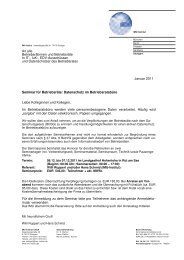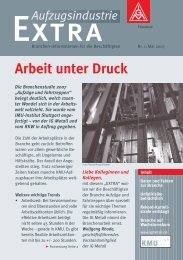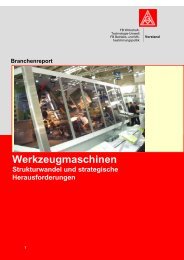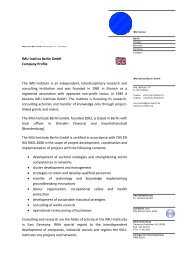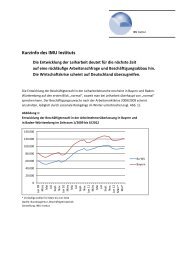Aufzüge und Fahrtreppen - IMU Institut
Aufzüge und Fahrtreppen - IMU Institut
Aufzüge und Fahrtreppen - IMU Institut
Sie wollen auch ein ePaper? Erhöhen Sie die Reichweite Ihrer Titel.
YUMPU macht aus Druck-PDFs automatisch weboptimierte ePaper, die Google liebt.
now also applied in China, Australia, Africa,<br />
South America and Eastern Europe.<br />
The scope of the term innovation should<br />
not be restricted simply to that of technical<br />
product innovation. Alongside the<br />
products themselves, new forms of services,<br />
technical processes and organizational<br />
structures also belong <strong>und</strong>er the<br />
heading of innovation. Consequently the<br />
extended version of the Industry Report<br />
looks not only at f<strong>und</strong>amental technical<br />
innovations such as the machine roomless<br />
lift, but also at product innovations<br />
in the service sector and process innovations<br />
in production and organization. The<br />
broader heading of innovation also includes<br />
issues such as on-demand maintenance,<br />
modularized maintenance, remote<br />
diagnosis, integral production systems,<br />
standardization and modularization as<br />
product strategies and so on.<br />
Lift construction SMEs in a<br />
process of adjustment<br />
Like the Big 4, there are a large number of<br />
small and medium-sized enterprises active<br />
in the industry who are also in the<br />
throes of restructuring processes. These<br />
are moved largely by the ever more prevalent<br />
predative competition in the new<br />
installation and modernization business,<br />
and also in the service sector. Tough competitive<br />
pressure and a process of concentration<br />
have been making their presence<br />
felt in the industry for years. A particularly<br />
damaging development for lift<br />
construction SMEs was the movement of<br />
the Big 4 towards standardization. This<br />
sealed their domination of the volume<br />
market, helped also by the advent of MRL<br />
concepts and the decline of the hydraulic<br />
lift. This trend has forced many lift construction<br />
SMEs into a decline over recent<br />
years, which in many cases ended in a<br />
major corporate crisis. Small and medium<br />
sized enterprises had no alternative but<br />
to respond, for instance by focussing<br />
more intensely on the niche strategies or<br />
streamlining and outsourcing production,<br />
often in the context of specialization<br />
on individual components and the<br />
increased external sourcing of other<br />
parts.<br />
Standardization and modular systems<br />
have now become an indispensable fact<br />
of life also for small and medium sized lift<br />
constructors. The larger players in this<br />
sector generally have their own “standardized<br />
basic range”. Smaller lift constructors,<br />
by contrast, frequently tend to<br />
turn to complete installation suppliers<br />
among the component manufacturers.<br />
An ever greater number of component<br />
manufacturers are following the market<br />
trend for purchasing everything they<br />
need from a single one-stop source and<br />
evolving into system suppliers. However,<br />
modular systems are only one side of the<br />
coin: The other at least equally important<br />
side, particularly among small and medium<br />
size lift constructors, is the manufacture<br />
of custom-produced lifts.<br />
Lift construction SMEs are generally specialized<br />
in a specifi c region (“regional top<br />
dogs with a good reputation and image”)<br />
and/or have strategically aligned themselves<br />
to specifi c fi elds (niche strategy).<br />
Among these enterprises, particularly<br />
those with their own production capacity<br />
or with a relatively high vertical range of<br />
production, tend to concentrate on oneoff,<br />
bespoke solutions. Their speciality<br />
lies either in areas such as batch size one<br />
production, or they gain a reputation in<br />
specialist areas such as panoramic lifts,<br />
ships’ lifts, inclined lifts etc. In some cases,<br />
this type of niche strategy constitutes<br />
a primary business unit which is supplemented<br />
by standard lift construction as<br />
secondary mainstay. All in all, the fortunes<br />
of many lift construction SMEs are<br />
determined by their customer proximity.<br />
They benefi t from extreme customer focus<br />
and an enhanced capacity to respond<br />
to individual customer requirements and<br />
enable detailed specifi cation of the product.<br />
Their benefi ts also include their fl exibility,<br />
their capacity for fast response and<br />
their reliability. Another point in their favour<br />
is their use of qualifi ed sales staff<br />
acting in the capacity of technical advisors<br />
who are able to directly address any<br />
requested modifi cations and integrate<br />
these into the product design.<br />
Component manufacturers<br />
A sector of the lift and escalator industry<br />
which is gaining increasingly in importance<br />
is that of the component manufacturers<br />
and full range suppliers. The greater<br />
the reduction in the vertical depth of<br />
manufacture among traditional producers,<br />
the higher the proportion of the production<br />
processes taken on by component<br />
manufacturers, which are becoming<br />
established increasingly on both a European<br />
and worldwide basis. One starting<br />
point for the development of the component<br />
industry were the international production<br />
concepts and component specialization<br />
strategies of the Big 4. The independent<br />
component manufacturers<br />
initially concentrated on individual parts<br />
such as doors, hydraulic drive systems,<br />
controls and so on. Among some component<br />
producers, there is a noticeable<br />
move towards the role of system supplier.<br />
For some years already, supply companies<br />
already existing in the lift construction<br />
sector have been moving increasingly towards<br />
the supply of construction kits and<br />
system solutions reaching well beyond<br />
their original supply sector. This type of<br />
full component range supplier has succeeded<br />
over recent years in achieving a<br />
signifi cantly greater market presence.<br />
There are now a whole series of full range<br />
suppliers who offer for instance small lift<br />
installation fi rms (without their own<br />
planning department) entire lift installations<br />
complete with documentation.<br />
Trends in employment and<br />
working conditions<br />
The number of jobs provided by the lift<br />
and escalator sector is receding, largely<br />
due to the plant closures of recent years.<br />
Job cuts are the logical consequence of<br />
the demographic shift in manufacturing<br />
over recent years, in particular in the production<br />
sector. For this reason alone,<br />
there is an unmistakable trend <strong>und</strong>er way<br />
towards a higher proportion of white collar<br />
workers, not only over the industry as<br />
a whole but also on a plant-related basis<br />
within the remaining producing locations.<br />
Alongside red<strong>und</strong>ancies as a result<br />
of closures, among the Big 4 there has also<br />
been a creeping cutback of jobs in<br />
many areas. A distinction must be made<br />
among the installers: In purely quantitative<br />
terms based on the number of jobs,<br />
the employment level appears to have remained<br />
steady over recent years seen<br />
across company bo<strong>und</strong>aries. However,<br />
there has been an immense shift here in<br />
terms of the quality of working conditions:<br />
The number of new lift installers<br />
have been drastically reduced among the<br />
key players, and their function largely<br />
farmed out to subcontractors <strong>und</strong>er less<br />
favourable working and pay conditions.<br />
36 LIFT-REPORT 33. Jahrg. (2007) Heft 6






